The impact of machine learning
Today’s world is flooded with data, and machine learning has been transforming how businesses deal with that data.
Even if you have not been following along in the details of machine learning and neural networks, these technologies are affecting your life. Amazon, Google, Facebook, Microsoft, and Baidu are all leveraging machine learning for tasks like interpreting human speech, translating between languages, recognizing images, and recommending products.
But the impact of machine learning in today’s business environment is too significant to be content with surface-level familiarity. From start-ups to Fortune-50 corporations, businesses increasingly rely on machine learning to remain competitive in a data-soaked environment.
- In a recent survey by MIT Sloan of enterprises with at least $500M in sales, 76% of the respondents claim that they are
- targeting higher sales growth with machine learning.
- More than a dozen European banks have replaced statistical modeling techniques with machine learning. The increased effectiveness and speed from this change has increased new product sales by 10%, reduced churn by 20%, and significantly boosted customer satisfaction and customer lifetime value.
- According to Fortune, venture capitalists are increasingly hesitant to invest in start-ups that are not using machine-learning technologies.
Machine learning is redefining and arming 21st century enterprise with greater predictive accuracy, value, and profitability. This whitepaper attempts to demystify machine learning and show how it can drive big benefits for your business.
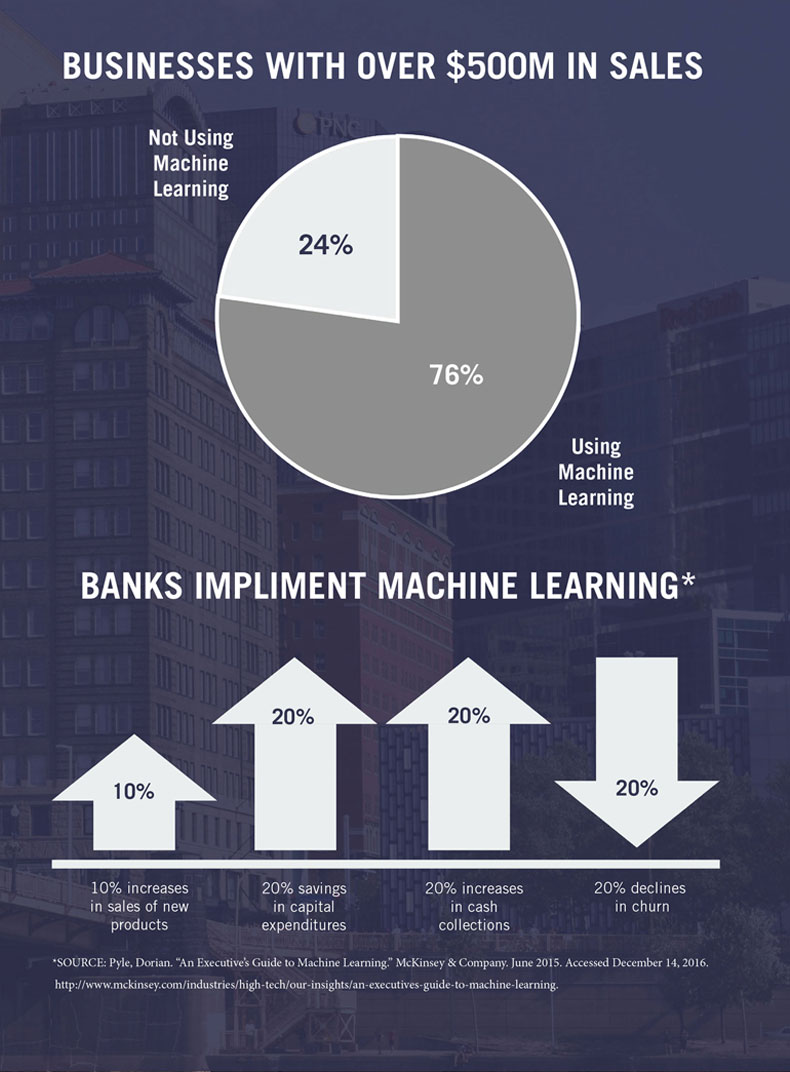
What is machine learning?
Traditionally, applications are programmed to make particular decisions if a particular scenario occurs based on predefined rules. These rules are based on human experience of the most frequently occurring scenarios. However, as the number of scenarios increases exponentially, it would demand massive investment to define rules to accurately address all scenarios, and either efficiency or accuracy is sacrificed.
Machine learning is a type of artificial intelligence that enables computers to learn without being explicitly programmed with predefined rules. It focuses on the development of computer programs that can teach themselves to grow and change when exposed to new data.
The weakness of the traditional business intelligence
Traditional business intelligence was based on the expertise of humans. Subject-matter experts would make hypotheses and define rules that represent those hypotheses in terms of measurable attributes—or business metrics. They then captured data from business processes and extracted and transformed this data into the metrics.
Business intelligence software would then process the data and evaluate the rules and provide reports. The human experts would then interpret these reports to validate their hypotheses and draw conclusions that would drive business decisions.
Traditional business intelligence in a modern business problem
Imagine you are programming your computer to recognize types of books so that you can recommend relevant books to your customers. How would you set up rules for what books are linked to other books? Genre? Release date? Authors? Style? Audience demographics?
Setting up rules for every category is impossible. What rules do you put in place to differentiate between science fiction and dystopian fiction? How will your computer recognize a fan of young adult novels or a student of biology? How would you teach a computer to identify genres?
As business needs become more complex and more customized, traditional business intelligence cannot handle the massive amounts of significant data with accuracy or speed. We need a stronger solution.
How is machine learning different from traditional business intelligence?
Machine learning is an algorithm or model that learns patterns in data and then predicts similar patterns in new data. In our book example, this means that instead of setting up precise rules for what counts as a children’s book, you feed the computer hundreds of examples of children’s books. The computer finds the patterns in those books and uses that pattern to identify future books in that category.
This predictive ability, combined with computers’ ability to process massive amounts of data, enables machine learning to handle complex business situations with efficiency and accuracy.
The power of machine learning
Machine learning algorithms do not depend on rules defined by human experts. Instead, they process data in raw form—text, email, documents, social media, images, voice, video, etc. Various types of learning algorithms locate patterns to draw conclusions.
As more and more data is processed, these algorithms continue to learn and improve their accuracy and validity of results.
The following chart summarizes the differences between conventional business intelligence and machine learning:
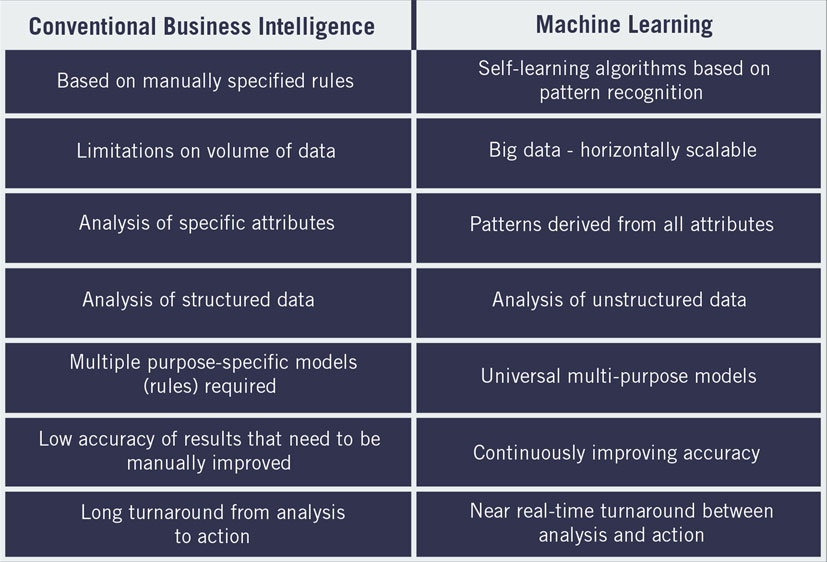
The growth of machine learning
Programmers and engineers have been developing and improving the technology behind machine learning for decades. At first, it was mainly used by data-based businesses and tech giants.
For example, Google uses machine learning in all its offerings from search to street view. Its street view technology can read street numbers and map all addresses in France in a matter of few hours—a feat that would have taken many weeks, if not months, in the past.
Similarly, in retail, Amazon uses algorithms based on machine learning to find similar products, quickly compare the prices of millions of products sold by other retailers, and use that data to provide the lowest possible prices to online shoppers.
Today, machine learning’s role in the business world is exploding beyond data-based companies. Thanks to the growing volume and variety of data available and the affordable storage and greater processing power of computing infrastructure, machine-learning algorithms are being adopted across most major industries.
Machine learning across industries
The use of machine learning is not restricted to the early adopters whose business is driven by big data. Today, machine learning algorithms are being adopted in various conventional industries. They are used in running medical diagnosis, predicting bad loans, detecting credit card fraud, and dozens of other scenarios.
Industries working with large amounts of data have realized the advantage of machine learning technology, and similar narratives can also be found in other sectors including healthcare, financial services, and transportation.
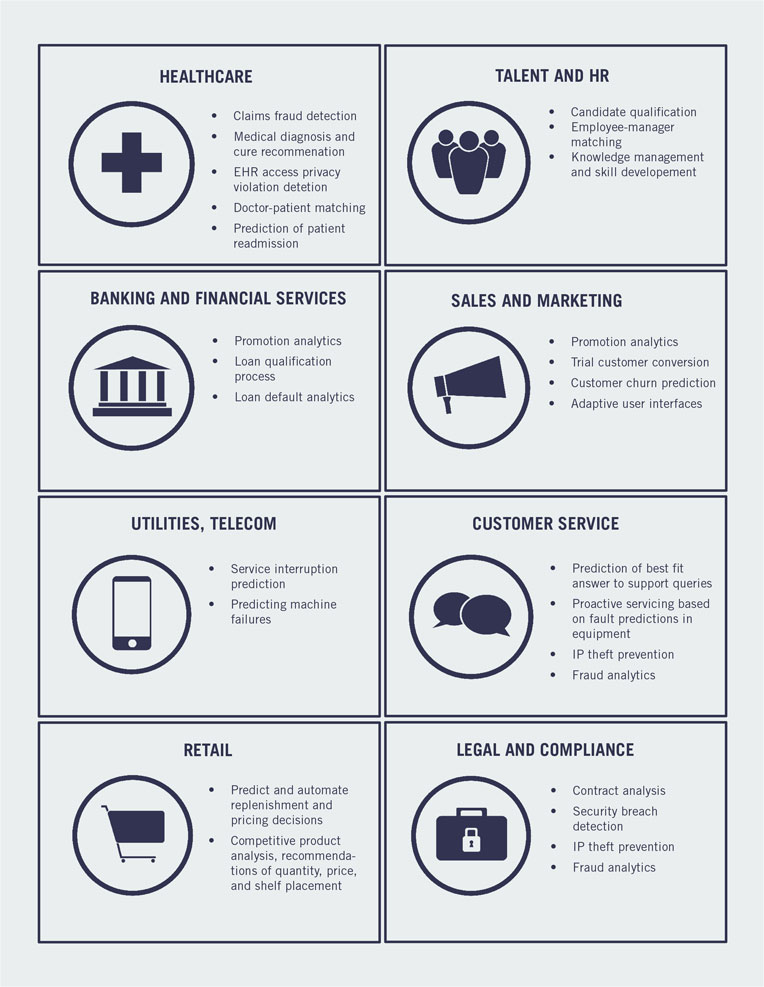
The two types of machine learning algorithms
Machine learning algorithms are categorized into supervised and unsupervised. Supervised algorithms apply what has been learned in the past to new data. Unsupervised algorithms can draw inferences from patterns in datasets.
Supervised Machine Learning
In supervised machine learning, the machine is “trained” on a predefined set of data or examples, which then facilitates its ability to make predictions when new data is given. In other words, a supervised learning algorithm is given a known set of data (input) and known responses to the data (output). The algorithm then trains a model to generate reasonable predictions for the response to new data. Supervised learning works with “labeled” data and is commonly used in applications where historical data predicts likely future events. For example, it can anticipate when credit card transactions are likely to be fraudulent or which insurance customer is likely to file a claim.
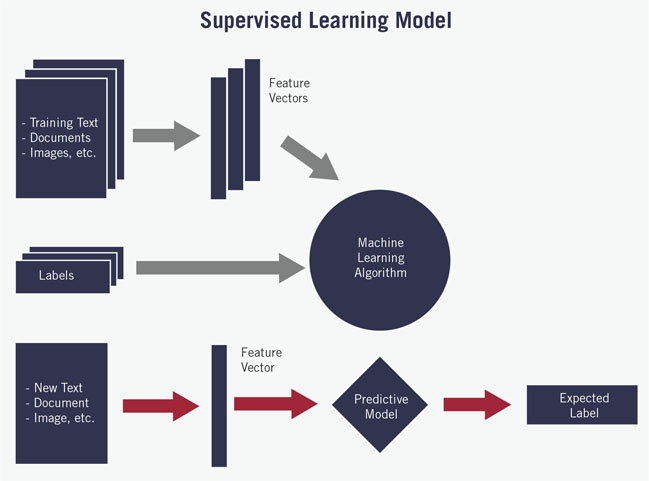
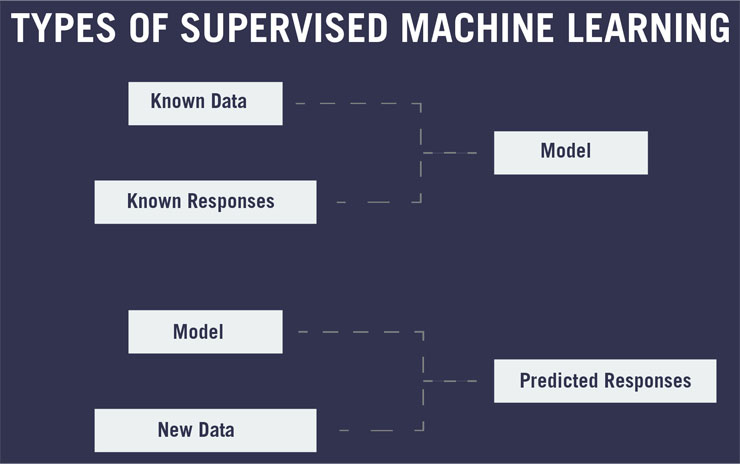
Supervised learning is split into two broad categories:
- Classification: These algorithms predict a discrete value by assigning a class (a label or a range of values) to a given input. For example, predicting the price of a house is a classification problem, and the possible classes could be ‘very costly’, ‘affordable’, and ‘cheap’. Applications using Classification model include spam filters, advertisement recommendation systems, and image and speech recognition.
- Regression: These algorithms predict a value from a continuous set. Applications include forecasting stock prices, energy consumption, or disease incidence.
Both regression and classification are related to prediction. However, regression predicts a value from a continuous set, while classification predicts whether something belongs to a certain class.
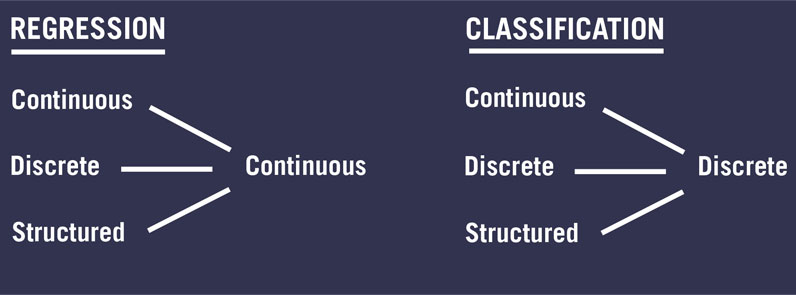
Unsupervised learning Model
In unsupervised learning, large sets of data are given as inputs to the machine to analyze. The algorithm then finds patterns and relationships to remember and classify.
Unlike supervised learning algorithms, which are initially trained with example output as well as input, unsupervised learning algorithms are only given input data. They must draw inferences from datasets consisting of input data without labeled responses.
The most common unsupervised learning method is clustering or cluster analysis.Clustering finds hidden patterns in data or groups its observations into meaningful groups or subsets (called clusters).
Clustering is a common technique for statistical data analysis. Its diverse applications include bioinformatics for sequence analysis and genetic clustering; data mining for sequence and pattern mining; and computer vision for object recognition.
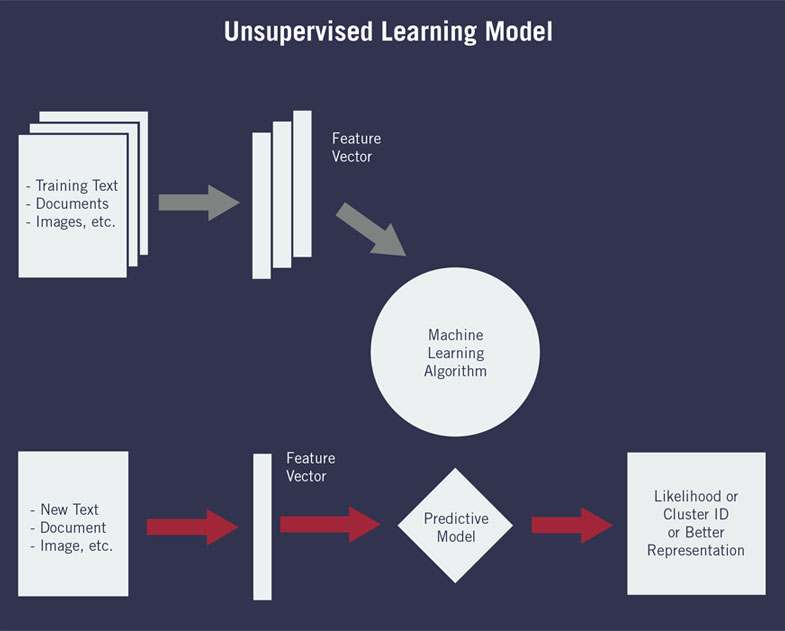
Deep Learning: An introduction
Deep Learning As a Subset of AI
The term “artificial intelligence” encompasses a vast range of technologies that enable computers and robots to solve problems in ways that mimic the human mind. Within that category is a smaller category called machine learning, which enables computers to improve at performing tasks with experience. Finally, within machine learning is the smaller subcategory called deep learning that permits software to train itself to perform tasks, like speech and image recognition, by exposing multilayered neural networks to vast amounts of data.
Deep Learning and the Human Brain
What are these neural networks, and how do they connect to deep learning? In computer science, a neural network is a system of hardware and/or software modeled after the operation of neurons in the human brain. Software modeled after neural networks are popularly referred as deep learning, though most scientists still prefer to call them by their original academic designation: deep neural networks.
The most remarkable thing about neural nets is that no human being programs a computer to perform any of the tasks mentioned above. Programmers feed the computer with a learning algorithm, & expose it to terabytes of data—hundreds of thousands of images or years’ worth of speech samples—to train it, resultantly allowing the computer to figure out for itself how to recognize the desired objects, words, or sentences.
Applications of Deep Learning
Today, neural networks are proving successful in a number of disciplines such as voice recognition and natural-language processing with applications such as handwriting recognition for check processing, speech-to-text transcription, oil-exploration data analysis, weather prediction and facial recognition.
Some companies are already integrating deep learning into their own day-to-day processes. For example, the sales team at Microsoft Research is already using neural networks to recommend products and to select prospects to contact.
Machine Learning—Implementation Process
- Machine Learning Model
- Insights & Action
- Problem Formulation
- Collect & Process Data
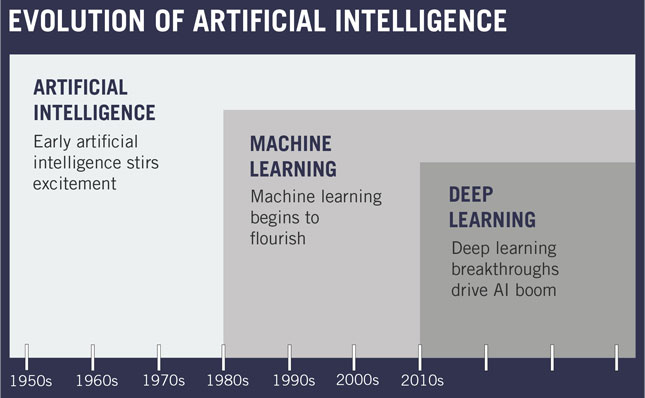
The Bottom Line
We deal with massive amounts of data today. In industries ranging from banking to retail to healthcare, machine learning is enabling businesses to leverage that data for greater accuracy and value.
Through machine learning, businesses can now automatically process large quantities of data and unlock the hidden value in them. Where high quantities of data was formerly an obstacle that clogged up computing systems, machine learning makes data a tool that trains algorithms and focuses those systems for fast and accurate results.
The data that enterprises have been saving for years can now be turned into tools for competitive advantage and result in faster realization of strategic goals.
Accion's experience in machine learning
Accion’s expertise in emerging technologies and modern software architecture makes us a natural partner to ally for designing and building your machine learning capability. Over the years, our teams have strengthened computing capabilities of numerous businesses from diverse sectors by modernizing and transitioning their application portfolio and helping customers gain more insights into their business with more actionable data.
Success Stories
- Web and Social Media Analytics
- E-Commerce
- Predicting customer behavior patterns from web usage logs and social media conversations
- Sentiment Analysis
- Classification
- Adaptive User Interfaces
- Healthcare
- UI that builds / modifies itself based on usage patterns
- Rule Extraction - related features made easy to access
- Analysis of Point of Sale Data
- Retail
- Leverage predictive analytics to build shopper-centric, responsive merchandising strategies
- Classification, Clustering
- Risk Profile Analysis
- Insurance
- Machine Learning Analysis of structured claims data along with unstructured data to identify high risk clusters of customer
- Regression Analysis
Your partnership with accionlabs
Whether your partnership with Accion Labs will look like strategic consulting, value-added staffing, or turn-key projects, we have the resources to make your implementation of machine learning smooth and successful. We recognize that depending on your stage of growth and your business model, your needs are different. Here are some of the ways we can work with you:
- For start-up and early-stage firms, we assist with pre- and post-funding product development and deployment for both B2B and B2C software firms. This enables us to help our clientele with lower time-to-market, lower cost-of-delivery and leverage our experience of product life-cycle best-practices – while building a foundation for world class engineering organization.
- For mid-stage and late-stage firms, we offer core product life-cycle services such as new product development, maintenance/support, QA/testing, managed services, re-engineering and others. Besides the product engineering lifecycle,we also offer a range of services for the Professional Services and Product Support organizations.
Get in touch with Accion today to find the best partnership for your business’ implementation of machine learning. Email us at info@accionlabs.com, or visit our website at: accionlabs.com
About Accionlabs
Accion Labs is a Pittsburgh-headquartered global technology firm specializing in working with technology firms and IT organizations in the emerging technologies such as Web 2.0, SaaS, Cloud, Open-source, BI/DW, Mobility, Automation, DevOps, and Big Data. Our clients include software product firms, e SaaS firms, e-commerce organizations and e-business organizations.
With an engineering headcount of over 800 resources spread over our 12 global offices, Accion engages with its clients in a range of collaborative, white-box engagement models that includes strategic consulting, value-added staffing, turn-key projects, offshore leveraged extended-delivery models, and a number of outcome- oriented collaborative development models.
Accion Labs is led by an entrepreneurial management team that believes in execution, outcome, continuous learning and worklife balance. Accion Labs is venture-funded, privately-held with offices in multiple locations in the US, UK, India, Singapore and Malaysia.
References
- An Introduction to Machine Learning Theory and Its Applications: A Visual Tutorial with Examples
- How to Prepare Data for Machine Learning
- Using Machine Learning to Predict NFL Games
- Machine Learning Is Redefining the Enterprise in 2016
- Why Deep Learning Is Suddenly Changing Your Life
